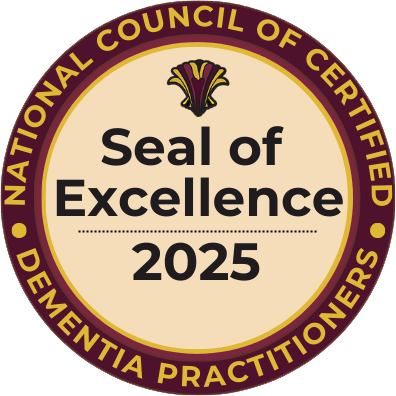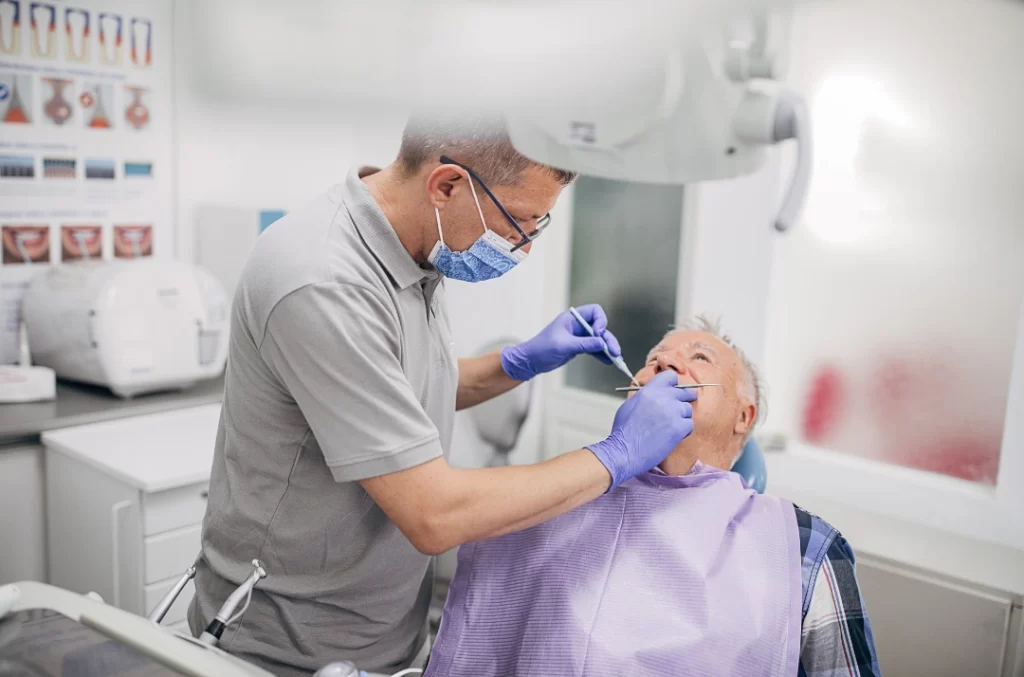A growing body of observational evidence links periodontal disease with higher odds of cognitive impairment and dementia, making poor oral healthcare a preventable risk factor.
This article follows the NCCDP in-service outline “Oral Health for Dementia Care” and integrates recent research and practice guidance for memory-care teams.
Why Oral Health Is A Dementia-Care Issue
Oral pain, dry mouth, root caries, and denture problems are common in dementia and directly affect eating, communication, behavior, and quality of life. U.S. surveillance shows substantial tooth loss and untreated caries in older adults, with marked disparities by income and education (Centers for Disease Control and Prevention [CDC], 2024). A growing body of observational evidence links periodontal disease with higher odds of cognitive impairment and dementia; recent meta-analyses (2024–2025) report small-to-moderate associations, while noting residual confounding and heterogeneity (Di Bello et al., 2024; Fu et al., 2024; Shivakumar et al., 2025).
Mechanisms To Keep In Mind
- Xerostomia (dry mouth) from anticholinergics, antidepressants, and other drugs increases caries risk and denture problems; the 2023 AGS Beers Criteria highlight cumulative anticholinergic burden in older adults (American Geriatrics Society [AGS], 2023; National Institute of Dental and Craniofacial Research [NIDCR], n.d.).
- Dysphagia and aspiration risk. Poor oral hygiene increases oral bioburden; evidence suggests that systematic oral care may reduce non-ventilator hospital-acquired pneumonia, though trial certainty varies (CDC, 2024; Cao et al., 2022).
- Nutrition link. Pain and ill-fitting prostheses impair chewing and intake, compounding weight loss and dehydration—key concerns in dementia nutrition guidelines (Volkert et al., 2024).
What Works: Evidence-Informed Practices
1) Daily oral-care protocols (staff-delivered and supported)
- Twice-daily toothbrushing with fluoride toothpaste and interdental cleaning; build routines into morning/evening ADLs (American Dental Association [ADA], 2024; CDC, 2024; NIDCR, n.d.).
- Denture hygiene: Clean after meals; remove and soak overnight; label and verify patient’s own prosthesis (National Institute on Aging [NIA], 2024; Mayo Clinic, n.d.).
- Low-burden behavior supports: Cueing, stepwise instructions, and caregiver presence—approaches emphasized in dementia-specific dental-care training (CareQuest Institute for Oral Health, 2024).
Impact on infections. Cochrane and related reviews in nursing homes suggest oral-care programs may reduce respiratory infections and pneumonia-related deaths, though certainty is low and results mixed; nonetheless, routine mouth care is low-risk and high-value for comfort, function, and potential infection reduction (Cao et al., 2022; Marusiak et al., 2023).
Practice caution with chlorhexidine. Recent network meta-analyses outside long-term care (e.g., ICU/VAP prevention) question chlorhexidine’s effectiveness and safety, so avoid automatic, prolonged use; target antiseptics to clinical indications and follow infection-control policies (De Cassai et al., 2024; CDC, 2024).
2) Preventive agents for high-risk older adults
- High-fluoride toothpaste (5,000 ppm) can inactivate and stabilize root caries lesions in older adults; consider for xerostomia or high caries risk (Nassar et al., 2023; León et al., 2025).
- Fluoride varnish (2.26% NaF) at 3–6-month intervals helps prevent and control coronal and root caries in adults (Fontana et al., 2024; ADA, 2023).
- Silver diamine fluoride (SDF) is a practical option to arrest cavitated root/coronal caries in frail or treatment-averse elders; discuss the trade-off of black staining (ADA, 2023; Kettelkamp et al., 2025).
3) Medication review for xerostomia
Collaborate with prescribers to reduce anticholinergic burden where feasible and to consider saliva-stimulating or substitutive therapies. Non-drug strategies include sipping water, sugar-free/xylitol gum or lozenges, and humidification (AGS, 2023; NIDCR, 2023).
4) Access and systems in long-term care
UK NICE guidance (NG48) and U.S. toolkits converge on: initial oral-health assessment on admission, personalized mouth-care plans, staff training, supply checklists, and referral pathways to community/geriatric dentistry (National Institute for Health and Care Excellence [NICE], 2016; CDC, 2024; Weening-Verbree et al., 2024/2025).
Clinical Red Flags In Dementia (What Staff Should Watch For)
Refusal to eat, new aggression during meals or hygiene, pulling at face or mouth, removing dentures, disturbed sleep, or vocalization may signal untreated oral pain; escalate to dental assessment promptly (NCCDP, n.d.; NIDCR, n.d.).
Implementation Playbook For Care Teams
- Screen & plan. On admission and quarterly: screen for natural teeth, dentures, pain, bleeding, dry mouth, dysphagia, and hygiene abilities; create a mouth-care plan with cueing needs and product list (NICE, 2016).
- Standardize daily care. Morning/evening protocol with fluoride toothpaste; interdental cleaning as tolerated; label and store dentures; post visual steps in bathrooms; track completion on ADL flowsheets (ADA, 2024; NIA, 2024).
- Escalate prevention. For high-risk residents (xerostomia, diabetes, prior root caries): add 5,000 ppm toothpaste and 3–6-month fluoride varnish; consider SDF for arrest when conventional restorations aren’t feasible (Nassar et al., 2023; ADA, 2023; Fontana et al., 2024).
- Coordinate with medical & rehab. Medication review (AGS Beers); screen for dysphagia and collaborate with SLPs and dietitians on texture, hydration, and safe-swallow strategies; maintain oral care to reduce oral pathobiota (AGS, 2023; CDC, 2024).
- Measure & improve. Track oral-care completion rates, dental referrals, weight change, aspiration events, and pneumonia ICD codes to evaluate program effect; reinforce staff skills quarterly (Weening-Verbree et al., 2024/2025).
Key Takeaways For Dementia Programs
- Oral health is integral to dementia comfort, nutrition, communication, and safety.
- Evidence supports routine mouth care, fluoride-based prevention, and team-based pathways; infection outcomes improve in some settings, though effect sizes vary.
- Focus on xerostomia management, fit/clean dentures, and behavior-supportive care to deliver consistent daily hygiene.
- Build partnerships with community/geriatric dentistry and use clear referral loops.
References:
American Dental Association. (2023). Silver diamine fluoride.
American Dental Association. (2024, August 8). Home oral care.
American Geriatrics Society. (2023). 2023 updated AGS Beers Criteria® for potentially inappropriate medication use in older adults.
Cao, Y., et al. (2022). Oral care measures for preventing nursing home-acquired pneumonia. Cochrane Database of Systematic Reviews.
CareQuest Institute for Oral Health. (2024, November 7). Oral health and dementia: Strategies to care for patients with cognitive decline (Webinar notes).
Centers for Disease Control and Prevention. (2024, March 27). Oral health in healthcare settings to prevent pneumonia: Toolkit.
Centers for Disease Control and Prevention. (2024, October 9). 2024 oral health surveillance report.
De Cassai, A., et al. (2024). Chlorhexidine is not effective at any concentration in preventing ventilator-associated pneumonia: Systematic review and network meta-analysis. Journal of Clinical Anesthesia.
Di Bello, V., et al. (2024). Impact of periodontal disease on cognitive disorders: Systematic review and meta-analysis. Journal of Clinical Periodontology.
Fontana, M., et al. (2024). Evidence-based approaches for caries prevention and management in adults. Journal of the American Dental Association.
Fu, Y.-D., et al. (2024). Meta-analysis of periodontal disease and Alzheimer’s disease. Journal of the Chinese Medical Association.
Kettelkamp, K., et al. (2025). Outcomes of SDF treatment in older adults: Narrative review. Geriatric Nursing.
León, S., et al. (2025). Dynamics of root caries in older adults using high-fluoride toothpaste: Randomized controlled trial. Journal of Dentistry.
Marusiak, M. J., et al. (2023). Professional oral-health care to prevent mouth–lung infection in long-term-care residents: Review. Frontiers in Medicine.
Mayo Clinic. (n.d.). Denture care: How do I clean dentures?
National Council of Certified Dementia Practitioners. (n.d.). NCCDP in-service toolkit: Oral health for dementia care.
National Institute for Health and Care Excellence. (2016). Oral health for adults in care homes (NG48).
National Institute of Dental and Craniofacial Research. (2023). Dry mouth and older adults: Information for caregivers.
National Institute of Dental and Craniofacial Research. (n.d.). Oral health and older adults.
National Institute on Aging. (2024, August 8). Taking care of your teeth and mouth.
Shivakumar, G. C., et al. (2025). How does oral health status correlate with cognitive decline in dementia? Umbrella review. The Open Dentistry Journal.
Volkert, D., et al. (2024). ESPEN guideline on nutrition and hydration in dementia (update). Clinical Nutrition.
Weening-Verbree, L. F., et al. (2024/2025). Oral health care in older people in long-term-care facilities: Implementation strategies. Geriatric Nursing / International Journal of Nursing Studies.























